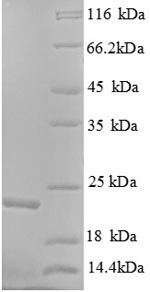The Human KRAS recombinant protein is conventionally generated by transfecting the recombinant DNA into a host cell, and then the host cells are cultured and the transfected DNA transcribed and translated. Different host cells can be chosen for recombinant protein production, the choice of which depends on the type of protein that needs to be generated, its functional activity and requisite yield. We choose E.coli as the expression system for this KRAS protein expression because bacteria cells are easy to culture, grow fast and produce high yields of recombinant protein.
KRAS is a protein coding gene that encodes GTPase KRas. According to some research, KRAS may have the following features.
KRAS mutation status predicts colorectal cancer response to cetuximab therapy. KRAS proteins play an important role in human cancers but have not yet succumbed to therapeutic attack. By determining the mutational status of EGFR and KRAS, treatment decisions regarding the use of these kinase inhibitors may be improved. GTPase KRAS inhibits the p53 tumor suppressor by activating the NRF2-regulated antioxidant defense system in cancer cells. The quantitative biophysical analysis identified key components that regulate the recruitment of the GTPase KRAS to the plasma membrane.






